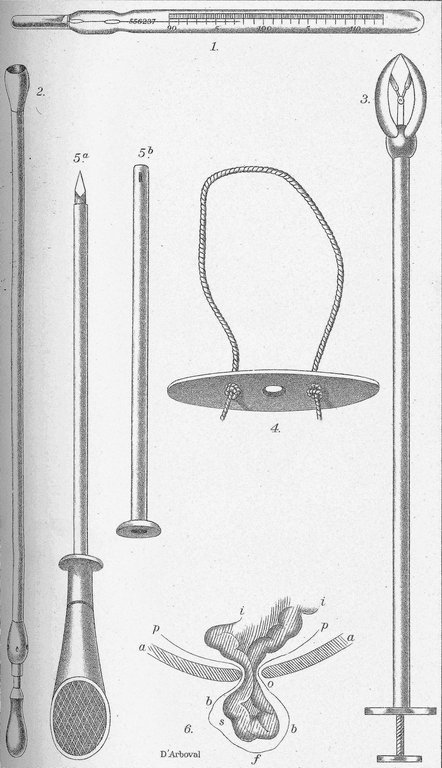
PLATE III.
INSTRUMENTS USED IN TREATING DISEASES OF DIGESTIVE ORGANS.

Plate III. Instruments used in treating diseases of digestive organs.
Fig. 1. Clinical thermometer, 4/5 natural size. This is used to determine the temperature of the animal body. The thermometer is passed into the rectum after having been moistened with a little saliva from the mouth, or after having had a little oil or lard rubbed upon it to facilitate its passage. There it is allowed to remain two or three minutes, then withdrawn, and the temperature read as in any ordinary thermometer. The clinical thermometer is made self-registering; that is, the mercury in the stem remains at the height to which it was forced by the heat of the body until it is shaken back into the bulb by taking hold of the upper portion of the instrument and giving it a short, sharp swing. The normal temperature of cattle varies from 100° to 103° F. In young animals it is somewhat higher than in old. The thermometer is a very useful instrument and frequently is the means by which disease is detected before the appearance of any external sign.
Fig. 2. Simple probang, used to dislodge foreign bodies, like apples, potatoes, eggs, etc., which have become fastened or stuck in the esophagus or gullet.
Fig. 3. Grasping or forceps probang. This instrument, also intended to remove obstructions from the gullet, has a spring forceps at one end in the place of the cup-like arrangement at the end of the simple probang. The forceps are closed while the probang is being introduced; their blades are regulated by a screw in the handle of the instrument. This probang is used to grasp and withdraw an article which may have lodged in the gullet and can not be forced into the stomach by use of the simple probang.
Fig. 4. Wooden gag, used when the probang is to be passed. The gag is a piece of wood which fits in the animal's mouth; a cord passes over the head to hold it in place. The central opening in the wood is intended for the passage of the probang.
Figs. 5a and 5b. Trocar and cannula; 5a shows the trocar covered by the cannula; 5b, the cannula from which the trocar has been withdrawn. This instrument is used when the rumen or first stomach becomes distended with gas. The trocar covered by the cannula is forced into the rumen, the trocar withdrawn, and the cannula allowed to remain until the gas has escaped.
Fig. 6. Section at right angles through the abdominal wall, showing a hernia or rupture. (Taken from D'Arboval. Dictionnaire de Médecine, de Chirurgie de Hygiene): a a, The abdominal muscles cut across; v, opening in the abdominal wall permitting the intestines i i to pass through and outward between the abdominal wall and the skin; p p, peritoneum, or membrane lining the abdominal cavity, carried through the opening o by the loop of intestine and forming the sac S, the outer walls of which are marked b f b.